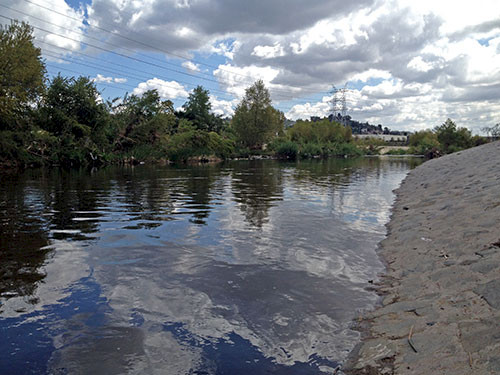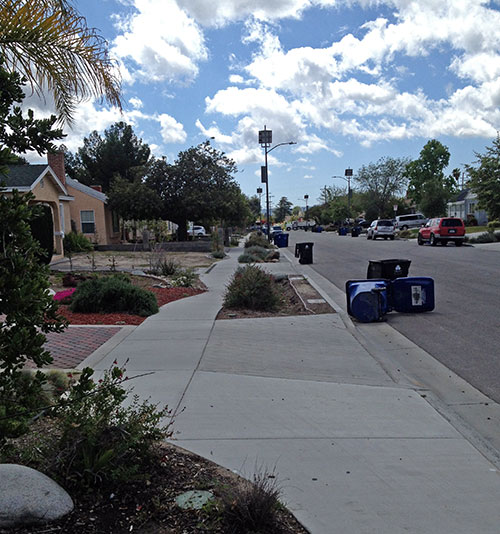The Los Angeles River: Geography, vistas and restoration
Bill Dennison ·Part 3. Restoration projects, organizations and impressions
This is Part 3 of a three part blog series on the Los Angeles River, based on a reconnaissance of the Los Angeles River conducted by Bill Dennison and Simon Costanzo from IAN, organized by the Council for Watershed Health on 1-2 April 2014. This blog focuses on various restoration projects and organizations.
Restoration project - Los Angeles State Historic Park ('The Cornfield'): This large scale restoration project is within walking distance of Los Angeles City Hall. They are about to begin the construction phase on an abandoned rail yard that runs perpendicular to the Los Angeles River. The locals call this empty lot "The Cornfield" because the railroad freight cars carried corn which would spill out of the trains parked in the rail yard. The corn kernels would germinate and volunteer corn stalks began growing in the spaces between the railroad tracks.
We met the Los Angeles Sector Supervisor, Sean Woods, who showed us the architectural drawings of the completed park. He showed us the location of a large water wheel which will be used to lift water out of the Los Angeles River at one end of the park, and then a series of artificial streams and wetlands used to irrigate the native vegetation that will be planted in the park. The park will include an orange grove, an outdoor amphitheater, large open green spaces and various natural and cultural history exhibits. A visitor center and ranger station will be constructed as well. We observed a beautiful little hummingbird flitting among the native plants that Sean has already planted. I look forward to revisiting this park when it is completed in approximately one year.

Restoration project - Marsh Park at Glendale Narrows: A series of small 'pocket parks' are being constructed along the river in the Glendale Narrows section. This is the section of the Los Angeles River that has a 'soft bottom'. We could see trees and shrubs growing out of the river bed and rapids formed over a cobble bottom. There was a bikeway along the levee and it was easy to walk down the sloping side to the edge of the edge of the flowing water. Nancy (Steele) talked about her kayak trip down through his section of the river during the previous summer. The park had some nice signage, lush vegetation and a spillway into the river, and it worked as the nicest stormwater retention device I have seen. We learned about the river rafting adventures that one particular group had undertaken. When they were denied a permit to raft the river, they applied for and were granted a filming permit. They proceeded to use the filming permit to access the river and then film themselves rafting.

Restoration project - Tujunga Wash greenway: This restoration project located in Burbank is a large greenway and stream restoration project on the Los Angeles River. It diverts stormwater from the main channel of the Los Angeles River using a gravity-fed pipe into a mile long rock-lined streambed up on the river levee. This stormwater is filtered by the steam side vegetation and sand and also infiltrates into the groundwater. Any remaining flow renters the river one mile downstream. There are nice bike and pedestrian paths on both sides of the river with a green corridor of drought tolerant vegetation. The project has calculated that the annual amount of groundwater recharge could provide 760 families with drinking water for a year.

Restoration project - Elmer Ave: This restoration project located in Sun Valley is an interesting streetscaping project in a neighborhood of Los Angeles where there are no stormdrains. Stormwater is designed in this neighborhood to simply runoff on the streets along the gutters to the Los Angeles River. The restoration project created sidewalks along street and in between the sidewalks and the street, a series of bioswhales were created. The bioswhales are shallow depressions connected to the street gutter via micro-culverts which allow the stormwater to flow from the street into the swale for groundwater infiltration as well as capturing runoff from the front yards of the houses. In addition, rain barrels were installed in many of the houses to capture rooftop runoff to be used for watering plants.
In addition to the city block fitted out with the bioswhales, an abandoned alleyway at the lower end of the street was rehabilitated into an extended infiltration corridor (Elmer Paseo). The Council for Watershed Health has installed various sampling equipment to quantify the impact on these restoration projects on stormwater runoff, and we saw the mock up of the information poles designed to house the sampling equipment and provide for public signage. The addition of solar powered street lighting, attractive and functional landscaping to replace an alley with abandoned cars and graffiti, and the creation of sidewalks have done an amazing amount of urban revitalization in addition to addressing a water issue.

Council for Watershed Health: The Council for Watershed Health (CWH) was formed in 1996. It is a non-government organization (NGO) with funding via grants and contracts from various city, county, state and federal government programs. CWH serves as a catalyst to bring different entities together to achieve various water management outcomes. A nice way to summarize CWH priorities was a word cloud used to form the outline of the Los Angeles River icon, a white heron. The word cloud was created by asking 170 people attending a 2013 watershed symposium to describe in one word their hopes for the future of the Los Angeles River. This word cloud was amazingly hopeful and positive, with large print words like 'vibrant', 'green', 'accessible', 'beautiful' and 'healthy' figuring prominently.
Urban Waters Federal Partnership Meeting: We attended the quarterly meeting of a group of people from various federal agencies, state and local governments and NGOs. The meeting was chaired by the Los Angeles River Ambassador Pauline Louie. It was apparent that there were many ongoing restoration activities and projects, as well as a diversity of different organizations involved.
Los Angeles River impressions: This opportunity to take a crash course on the Los Angeles River opened my eyes to a variety of new perspectives. Perhaps the most powerful impression that I came away with was the energy and excitement that is growing to reconnect citizens with the river. This perspective was obtained by viewing restoration projects, talking with Council for Watershed Health staff and attending the Urban Waters Federal Partnership Meeting. Another impression was the need to tell the river stories through effective science communication, environmental report cards and active engagement with citizens. The Los Angeles River has been termed an 'open sewer' carrying 'urban slobber' through a forbidding concrete raceway. These out-dated perceptions need to be replaced with a different narrative so that the river restoration activities can be accelerated. The other major impression that I have is the importance of restoring this highly modified and famous river in a highly urbanized megacity as a model for the dramatic expansion of megacities globally. 'Getting it right' in Los Angeles will go a long way in setting an example for other rivers in urban settings.
About the author
Bill Dennison

Dr. Bill Dennison is a Professor of Marine Science and Vice President for Science Application at the University of Maryland Center for Environmental Science.